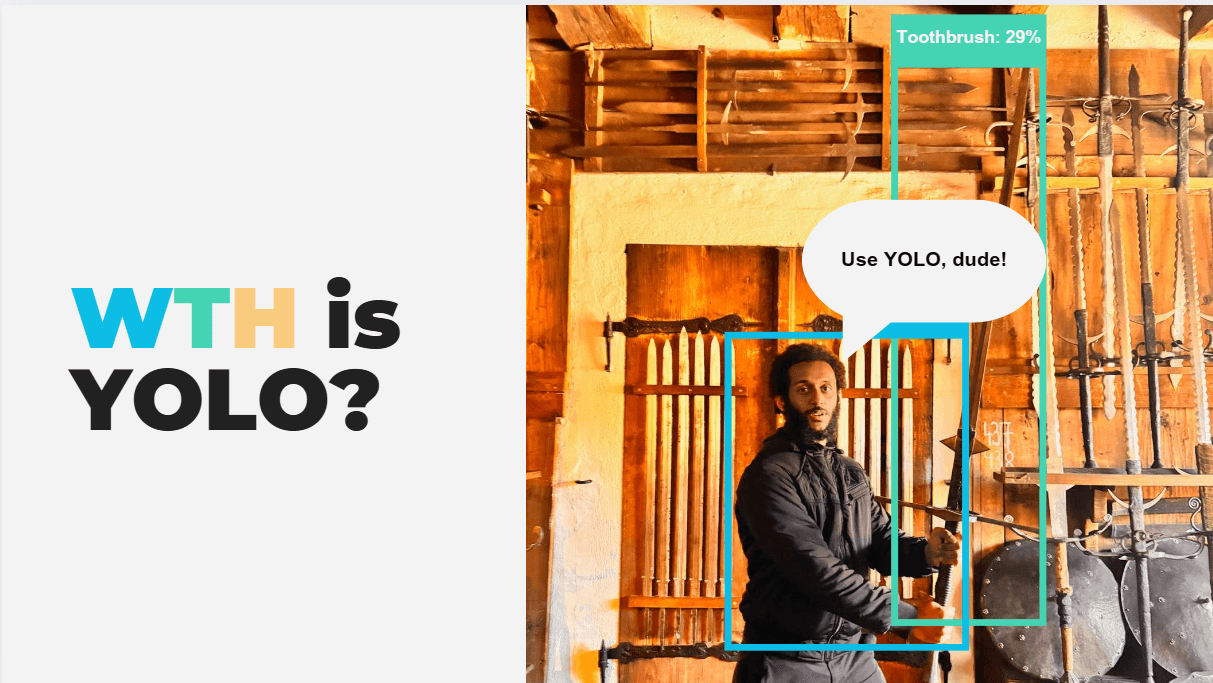
Open this Repository and play along with the python interactive notebook: Python Notebook
Get the PowerPoint slides here: PowerPoint Slides
Introduction
- Brief overview of object detection and its importance in AI.
- Introduction to YOLO and its revolutionary approach as a single neural network predicting bounding boxes and class probabilities directly from full images.
YOLO Overview
- Explanation of the YOLO model and its architecture.
Theoretical Concepts
Unified Detection: Explanation of how YOLO integrates various aspects of object detection into a single neural network.
- The grid system.
- Bounding box prediction.
- Class probability prediction.
Network Design: Detailed breakdown of the convolutional network used by YOLO. Discussion on the choice of network architecture.
- Benefits of 1x1 reduction layers followed by 3x3 convolutional layers.
- Loss Function: Analysis of the YOLO loss function and its components.
- Importance of various terms in the loss function.
- Challenges in training due to imbalanced classes (object vs no-object).
Practical Implementations
- Setting Up YOLO: Steps to configure the YOLO framework for object detection. How to prepare data and annotations.
- Setting up the network configuration.
- Training YOLO: Guide on how to train YOLO with custom datasets.
- Adjusting parameters for training.
- Monitoring training progress.
- Using Pre-trained Models: How to use pre-trained YOLO models for detection tasks.
- Loading pre-trained weights.
- Running detection on new images.
Applications of YOLO (OUR PERSONAL DEMO)
- Real-time object detection: Discuss the ability of YOLO to process video streams.
- Integration with robotics for autonomous navigation.
- Use in advanced driver-assistance systems (ADAS) for real-time vehicle and pedestrian detection.
- Custom applications: Building a simple application to demonstrate object detection in artwork or other specialized fields.
Comparison of YOLO with Other Object Detection Models
Overview of Object Detection Models
- Brief introduction to the landscape of object detection.
- Mention key technologies like R-CNN, Fast R-CNN, Faster R-CNN, SSD (Single Shot MultiBox Detector), and Mask R-CNN.
R-CNN and Its Variants
- R-CNN: Explain the Region-based Convolutional Neural Networks (R-CNN) and its process using selective search to propose regions.
- Fast R-CNN: Discuss improvements over R-CNN, introducing ROI pooling to speed up processing by sharing computations.
- Faster R-CNN: Introduction of Region Proposal Networks (RPNs) that share full-image convolutional features with the detection network, improving both speed and accuracy.
SSD (Single Shot MultiBox Detector)
- Explain the architecture of SSD which predicts bounding box locations and class probabilities in a single pass of the network.
- Compare SSD's approach to YOLO, emphasizing differences in speed, accuracy, and complexity.
Mask R-CNN
- Extend Faster R-CNN by adding a branch for predicting segmentation masks on each ROI, in parallel with the existing branch for classification and bounding box regression.
- Discuss the applicability of Mask R-CNN for tasks that require instance segmentation which is beyond the scope of YOLO.
Direct Comparison
- Speed: Compare the inference time of YOLO with other models, particularly highlighting its advantages in real-time applications.
- Accuracy: Discuss how the mean Average Precision (mAP) of YOLO compares with other models across standard datasets like MS COCO and PASCAL VOC.
- Ease of Training: Evaluate the complexity of training each model, considering aspects like data preparation, tuning, and computational resources.
- Flexibility: Discuss the adaptability of each model to various changes in input size, aspect ratios, and object scales.
Use Cases
- Highlight specific scenarios where one model might be preferred over another due to considerations like computational efficiency, accuracy needs, or real-time processing requirements.
- Examples where YOLO might be preferred for real-time detection and scenarios where a more precise but slower model like Mask R-CNN could be more suitable.
Visual Examples and Benchmarks
- Provide visual examples of each model’s output on the same set of images for direct visual comparison.
- Include a table or chart comparing the key performance metrics (speed, accuracy, resource usage) of each model.
Advantages and Limitations
- Discussion on the strengths of YOLO, including speed and accuracy.
- Limitations of the YOLO architecture and potential areas of improvement. Comparison with other state-of-the-art models in terms of speed and performance.
Future Directions
- Potential enhancements in YOLO architecture.
- Exploration of newer versions of YOLO (like YOLOv3, YOLOv4, etc.).
- Discussion on open problems in object detection and how YOLO can adapt.
Conclusion
Summary of what YOLO achieves and its impact on the field of computer vision and object detection
What is YoLo?
- State of the Art object detection Algorithm
How it works?
- Architecture
- How it identifies bounding boxes
- It detects overlapping boxes but we can remove them.
Why its better than other Models like DPM and R-CNN(fast, faster)?
- 1 layer feedforward
- Fast kichaww
- Easier implementation? (Lines of code and CLI)
Applications Demo
- It can be used for self driving cars
- AimBot for first person shooter games.
Ethical Questions:
- Using it for military purposes(one of the creators had this concern).